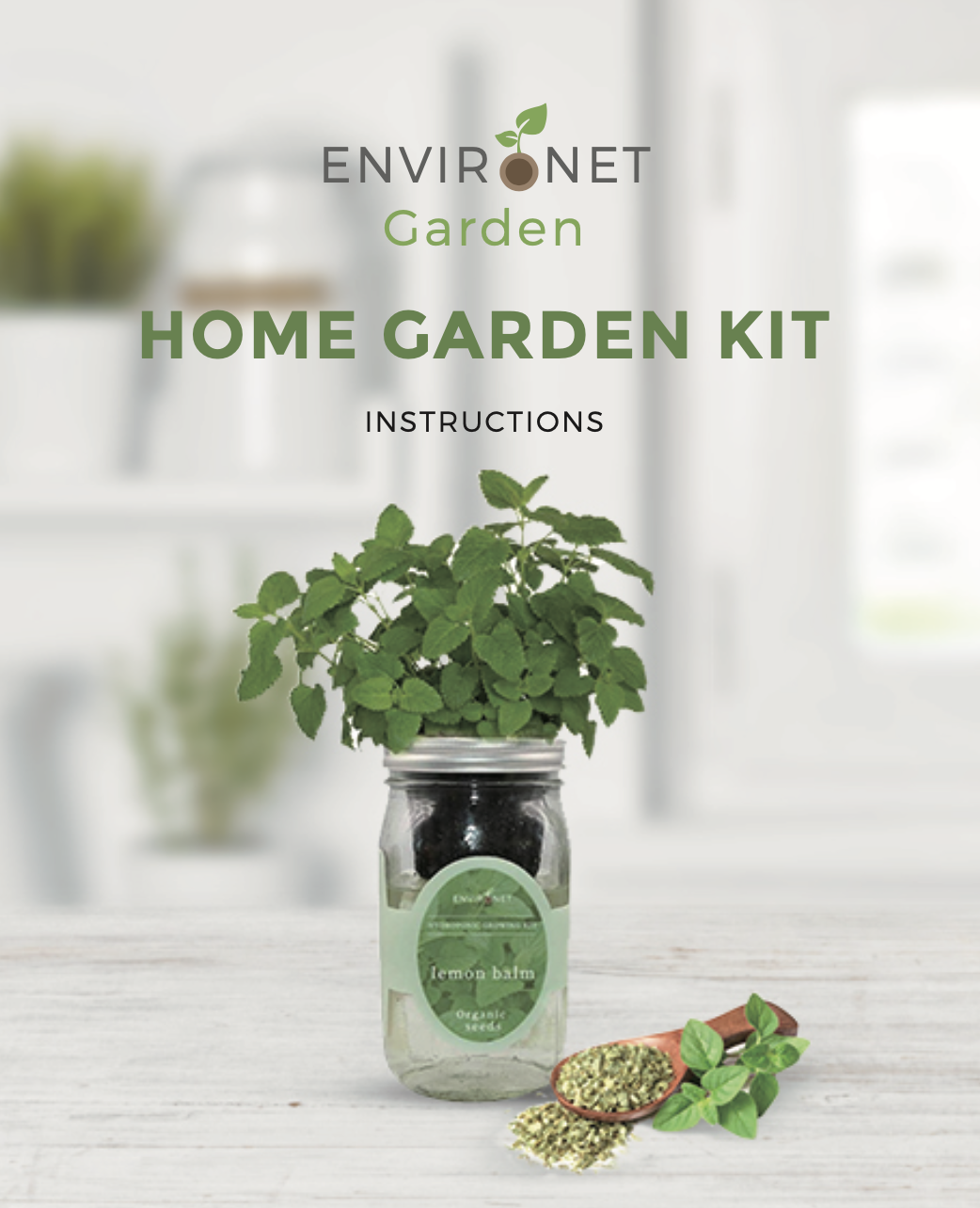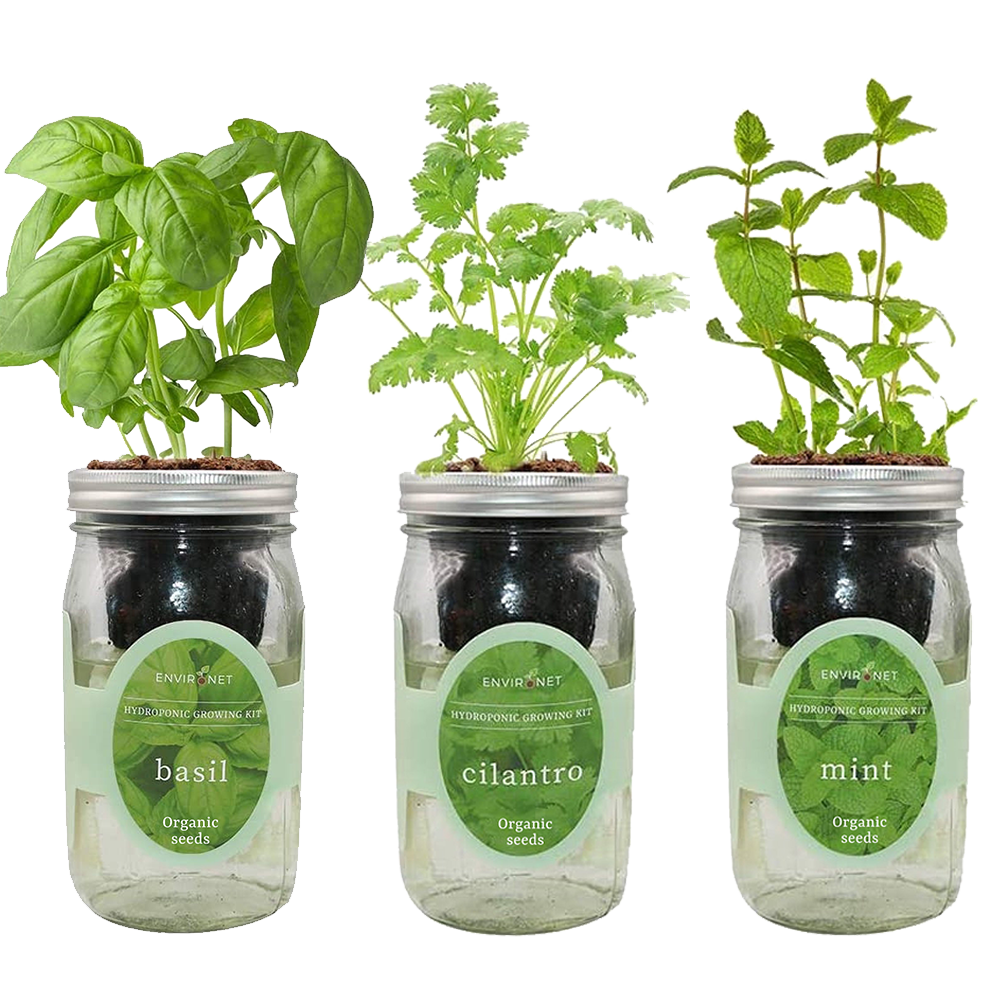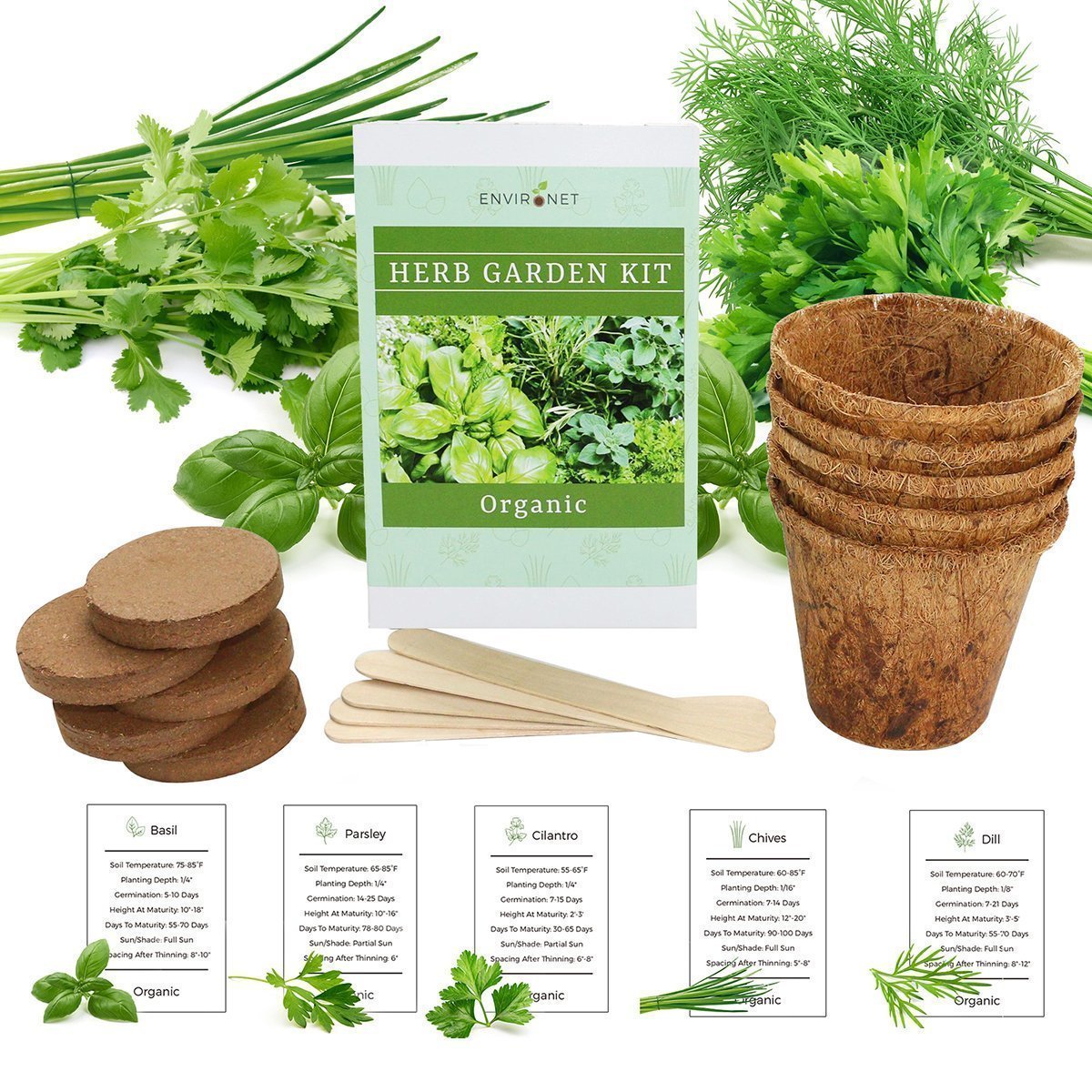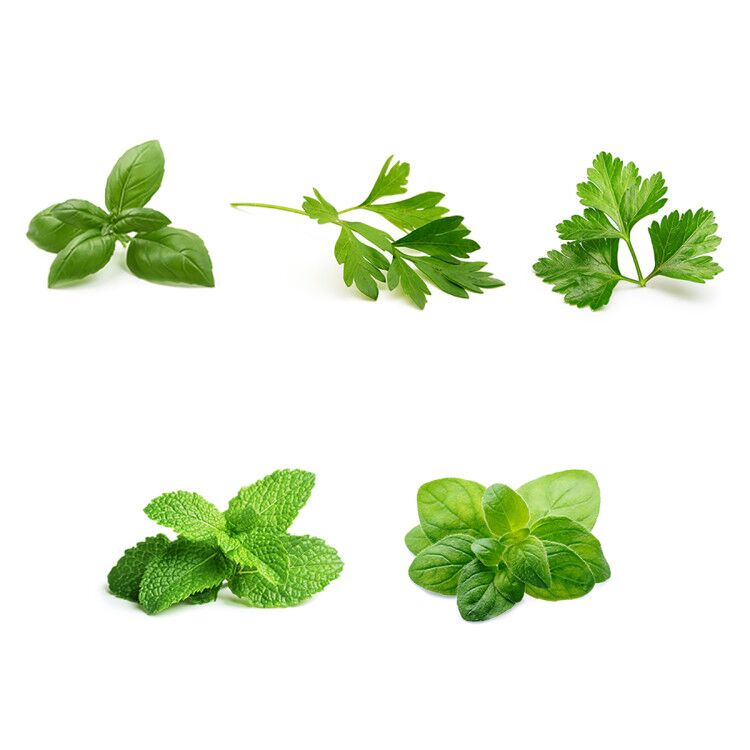Hydroponic Kit
Water, light and nutrients are essential for plant to grow. To have a successful experience with your hydroponic kit, please follow these instructions.
Start Growing
- Remove the band and the net pot from the mason jar
- Add 2 cups (16 oz) of water to the mason jar
- Place the net pot and the band back to the mason jar
- Leave the circle plug cover on the growth plug for up to 7 days or until the seeds germinate. The plug cover keeps the plug surface moist which helps germination.
Plant Food
Plant food is not included in this kit due to regulations. Recommend liquid plant food for vegetables available on Amazon (such as Dyno-Gro Grow 7-9-5).
Follow instructions on plant food packaging to fertilize your hydroponic kit.
Watering
When water level drops below 8 oz (about 1/3 of the mason jar), add water to 16 oz (about 2/3 of the mason jar). No need to replace water.
Light
Light is essential for plant to grow. If you have access to windowsill, put the kit on windowsill to get sunlight. Otherwise you can place the kit under LED plant-growing lights for 16 hours a day as substitute of sunlight.
You can buy LED lights from Amazon.
Restart Your Kit
After each planting, clean the mason jar, remove roots on the grow plug. Place seeds 1/4" deep in the grow plug. Then repeat the "Start Growing" steps.
You can order pre-seeded plugs from our Amazon store. The links to the preseeded plugs are:
https://www.amazon.com/dp/B08LBKM1QG?ref=myi_title_dp
https://www.amazon.com/dp/B08L6FSX6Y?ref=myi_title_dp
Seed Kit
Prepare the soil
Place a soil wafer in a large bowl. Slowly add one cup (8 oz) of water. After wafer expands, stir to aerate.
Potting the soil
Gently move the soil into one of the pots (do not press the soil). Make sure save a little soil to cover your planted seeds.
Planting
Open a seed envelope. Sprinkle some seeds over the soil. Cover the seeds with the soil you set aside. Refer to the instruction on the seed envelope for planting depth.
Watering
Keep the soil moderately moist for healthy growth of your plant. Avoid over watering. If you are unsure about the moisture level, you can use a soil moisture meter or sensor. Some smart sensors can alert you when the soil is too dry or too wet.
Light
Herbs and vegetables rely on light to grow. If you have access to windowsill, put the pots on windowsill to get sunlight. Otherwise you can place the pots under led plant-growing lights for 16 hours a day as substitute of sunlight.
Air & Temperature
Keep your pots in a place with good air circulation to avoid or reduce growth of fungi, bacteria and viruses. Refer to the instructions printed on the seed packets for the recommended temperature range. Make sure the place you put pots does not get too hot or too cold.
Fertilizer
Fertilizer is not needed until transplanting. If you keep plant in the pots, add water soluble fertilizer after four months. Beneficial fungi may appear, stir back into soil.
Thinning
When seedlings grow to 3-4 inches tall, you should cut those seedlings that are not as strong, so that the strong seedlings better resource to grow.
Transplanting
Environet seed kit pots are 100% bio-degradable. You can place the pot in a garden bed hole. This has minimum damage to the root.
If you want to reuse the coca coir pot, you can remove the plant from the pot by genetally squeezing the sides to loose the soil.
Basil
Annual The pleasant lemon fragrance of this basil makes it a great accompaniment for fish. It is also excellent in teas, potpourris, and dried arrangements. The plant bears light-green leaves and small, white flowers on 24" stalks.
Did You Know? Basil is rich in vitamin K and beta-carotene, natural anti-inflammatory ingredients.
Soil Temperature: 75-85°F
Planting Depth: 1/4"
Germination: 5-10 Days
Height At Maturity: 10"-18"
Days To Maturity: 55-70 Days
Sun/Shade: Full Sun
Spacing After Thinning: 8"-10"
Parsley
Biennial Italian parsley is a glossy flat-leaf variety that is called for in many gourmet recipes. It's excellent for seasoning, with a stronger flavor than many curly types. It turns bitter when it bolts.
Did You Know? Parsley is rich in vitamins A, C, several Bs, and calcium and iron.
Soil Temperature: 65-85°F
Planting Depth: 1/4"
Germination: 14-25 Days
Height At Maturity: 10"-16"
Days To Maturity: 78-80 Days
Sun/Shade: Partial Sun
Spacing After Thinning: 6"
Cilantro
Annual Similar in appearance to parsley, cilantro is a staple in Mexican, Indian, and Asian cuisines. This bolt-resistant variety produces lush growth. The seeds of the plant can be harvested and are called coriander.
Did You Know? Cilantro is Spanish for coriander.
Soil Temperature: 55-65°F
Planting Depth: 1/4"
Germination: 7-15 Days
Height At Maturity: 2'-3'
Days To Maturity: 30-65 Days
Sun/Shade: Partial Sun
Spacing After Thinning: 6"-8"
Chives
Hardy Perennial Also called Chinese leeks, garlic chives resemble regular chives except that their leaves are shiny and flat. The plant bears beautiful, white flower heads. The distinct garlic flavor of these chives makes them a great choice for adding to salads, omelets, and stir-fry dishes. Chives are useful as a companion plant throughout the garden.
Did You Know? Freeze-drying is the best drying method to preserve the chive's delicate flavor.
Soil Temperature: 60-85°F
Planting Depth: 1/16"
Germination: 7-14 Days
Height At Maturity: 12"-20"
Days To Maturity: 90-100 Days
Sun/Shade: Full Sun
Spacing After Thinning: 5"-8"
Dill
Annual Earlier blooming than Mammoth dill, Bouquet dill has large seed umbels and dark-green foliage. Dill provides a great beneficial-insect habitat in the garden and can reseed prolifically. Dill is used in many pickling recipes as well as in seafood, soups, sauces, and potatoes.
Did You Know? Plant dill to be harvest-ready at the same time as cucumbers for the perfect pickling pair.
Soil Temperature: 60-70°F
Planting Depth: 1/8"
Germination: 7-21 Days
Height At Maturity: 3'-5'
Days To Maturity: 55-70 Days
Sun/Shade: Full Sun
Spacing After Thinning: 8"-12"
Mint
Soil Temperature: 75-85°F
Planting Depth: 1/4"
Germination: 15-21 Days
Height At Maturity: 10"-18"
Days To Maturity: 55-70 Days
Sun/Shade: Full Sun
Spacing After Thinning: 8"-10"
Oregano
Tender Perennial Traditional Italian Oregano. This is a culinary, large-leaved variety with white flowers. Use oregano leaves dried or fresh in chili, tomato sauce, meats, and pizza.
Did You Know? Oregano flowers are edible and a nice addition to a salad or dish!
Soil Temperature: 60-70°F
Planting Depth: 1/16"
Germination: 7-14 Days
Height At Maturity: 12"-18"
Days To Maturity: >100 Days
Sun/Shade: Partial Sun
Spacing After Thinning: 6"-8"
Sage
Perennial This is a culinary, large-leaved sage variety. Used both dried and fresh, sage leaves are a popular poultry and meat seasoning. Sage also makes a soothing tea.
Did You Know? While a sage plant is in its prime, it makes an attractive addition to both herb gardens and ornamental borders. Pruning after flowering will keep the plant from getting too leggy or woody.
Soil Temperature: 65-70°F
Planting Depth: 1/16"
Germination: 7-21 Days
Height At Maturity: 18"-30"
Days To Maturity: >365 Days
Sun/Shade: Partial Sun
Spacing After Thinning: 12"-18"
Thyme
Hardy Perennial Short, compact, aromatic herb. This winter hardy variety has attractive tiny lavender flowers. Thyme is known to deter cabbage worms. It's aromatic leaves are used in sauces, soups, and stews. It is great seasoning for poultry and fish, and adds just the right amount of zest to salads.
Did You Know? Thyme has been used medicinally for centuries to treat certain parasites and a broad range of respiratory ailments.
Soil Temperature: 60-70°F
Planting Depth: 1/16"
Germination: 21-28 Days
Height At Maturity: 8"-12"
Days To Maturity: 90-100 Days
Sun/Shade: Full to Partial Sun
Spacing After Thinning: 6"-12"
Sorrel
Perennial Heirloom. Sorrel shows up early and stays late in your garden, offering lemony leaves at the beginning of spring through the end of fall. Perennial in USDA zones 4-9. For the best flavor, pick the leaves when young, succulent, and tender. Sorrel adds citrusy brightness to salads and as an accent to rich fish or dairy dishes. It is a traditional source of cool-season Vitamin C.
Did You Know? Sorrel is also called "Lemonade In A Leaf" due to its citrusy, refreshing flavor.
Soil Temperature: 65-75°F
Planting Depth: 1/4"-1/2"
Germination: 4-10 Days
Height At Maturity: 10"-16"
Days To Maturity: 35-60 Days
Sun/Shade: Full Sun
Spacing After Thinning: 12"-18"
Lemon balm
Perennial Lemon Balm is a member of the mint family and has fragrant lemon-scented leaves and clusters of small white flowers that are attractive to bees. Lemon Balm's botanical name "Melissa" is Greek for "honey bee". The leaves can be used for flavoring teas, ice cream, fruit or in pesto and also have medicinal qualities. Lemon Balm is often included in sachets and potpourris.
Did You Know? Lemon Balm is used as a flavoring in some toothpastes.
Soil Temperature: 70°F
Planting Depth: 1/8"
Germination: 14-21 Days
Height At Maturity: 24"-36"
Days To Maturity: 35-60 Days
Sun/Shade: Partial Sun
Spacing After Thinning: 12"-15"
Tarragon
Tender Perennial grown as Annual Heirloom. Yellow-orange flowers top the branches of this Mexican native from the marigold family. Long leaves are even more flavorful than French Tarragon, with more anise. Use as a spice in egg, chicken, and meat dishes, or with steamed green beans. Grows well in hot climates where French Tarragon does not survive.
Did You Know? Try this instead of French Tarragon when making flavored vinegar.
Soil Temperature: 60-70°F
Planting Depth: 1/2"
Germination: 7-14 Days
Height At Maturity: 2'
Days To Maturity: 90-100 Days
Sun/Shade: Full to Partial Sun
Spacing After Thinning: 18"
Fennel
Tender Perennial Heirloom. Non-bulbing fennel grown for bronze, flavorful leaves and seeds; plant Florence fennel for edible bulbs. Leaves have a springy, anise taste; seeds are used in Italian sausage, Middle Eastern and Indian cuisine. Feathery leaves spread out as edible landscaping backdrop for vegetables or flowers. Self-sows readily.
Did You Know? Swallowtail butterflies use this as both egg site and larvae food.
Soil Temperature: 65-75°F
Planting Depth: 1/2"
Germination: 10-15 Days
Height At Maturity: 2'-4'
Days To Maturity: 50-60 Days
Sun/Shade: Full Sun
Spacing After Thinning: 12"
Mint
Did You Know? This plant will attract and feed a variety of beneficial insects, bees and even birds.
Soil Temperature: 75-85°F
Planting Depth: 1/4"
Germination: 15-21 Days
Height At Maturity: 10"-18"
Days To Maturity: 55-70 Days
Sun/Shade: Full Sun
Spacing After Thinning: 8"-10"
Kale
Biennial An equal mix of Red Ursa kale, Scarlet kale, Vates kale, White Russian kale and Lacinato kale. Plant in the spring or fall.
Did You Know? In Scotland kale was such a vital crop that the word "kail" was synonymous with "food".
Soil Temperature: 55-75ºF
Planting Depth: 1/4-1/2"
Germination: 5-10 Days
Height At Maturity: 24-36"
Days To Maturity: 30-65 Days
Sun/Shade: Part Sun
Spacing After Thinning: 16"
Marjoram
Perennial Marjoram will not survive harsh northern winters outdoors. Its leaves are used in vinegar, soups, salads, dressings, roast lamb, and tomatoes. It is native to northern Africa and southwest Asia.
Did You Know? Marjoram is one of the most fragrant herbs known. The plant fills the air with scent even when gently brushed against.
Soil Temperature: 60-70°F
Planting Depth: 1/16"
Germination: 10-14 Days
Height At Maturity: 12"-24"
Days To Maturity: 62-80 Days
Sun/Shade: Full Sun
Spacing After Thinning: 6"-8"
Calendula
Annual These orange flowers tolerate heat, and bloom from early summer through light frosts and light snow in autumn. Use as a coloring substitute for saffron in cooking, as an edible flower with a nutty flavor, or as an ingredient in skin creams.
Did You Know? Also known as Pot Marigold, although it is not related to the common marigold Tagetes spp.
Soil Temperature:65-70°F
Planting Depth: 1/4"
Germination: 7-14 Days
Height At Maturity: 12"-24"
Days To Maturity: 40-50 Days
Sun/Shade: Full to Partial Sun
Spacing After Thinning: 10"-12"
Pepper, Hot Jalapeño Early
Annual This historic chili was developed over a hundred years ago by Dr. Fabian Garcia. This chili was selected by Dr. Garcia to have a milder, fresher, flavor than most chilis, with thick meaty walls, and large peppers up to 8" long. This is a very popular chili in southwestern cuisine and you will see it roasted, fresh, dried, and canned. It is most often used when it is dark green, but it will become hotter and turn bright red as it matures.
Did You Know? Anaheim peppers are named after the city of Anaheim in California. The heat can vary on where this pepper is grown.
Soil Temperature: 75-85°F
Planting Depth: 1/4"
Germination: 14-21 Days
Height At Maturity: 24"-38"
Days To Maturity: 70-90 Days
Sun/Shade: Full Sun
Spacing After Thinning: 12"-24"
Pepper, Sweet Nardello
Annual Heirloom. Delightful fresh or fried, this pepper is also a sweet non-bell pepper when ripe. An Italian heirloom preserved by the Nardello family. Red when ripe, these 6"-8" peppers have shiny, wrinkled skins.
Did You Know? Mr. Nardello's mother originally brought the seeds with her when she immigrated to the U.S. in 1887 with her husband Giuseppe.
Soil Temperature: 70-90°F
Planting Depth: 1/4"
Germination: 8-14 Days
Height At Maturity: 18"-30"
Days To Maturity: 65-75 Days
Sun/Shade: Full Sun
Spacing After Thinning: 12"-18"
Red Robin Tomato
Biennial Heirloom More compact, strong vigorous determinate vines, bright red 6-8 oz. fruit with excellent flavor. Early variety for canning and juicing. Fusarium wilt and Verticillium wilt resistant.
Did You Know? This variety was originally developed by the Campbell's Soup Company in the 1920s and improved upon by Rutgers University.
Soil Temperature: 70-85°F
Planting Depth: 1/2"
Germination: 6-12 Days
Height At Maturity: 4-5'
Days To Maturity: 73-86 Days
Sun/Shade: Full Sun
Spacing After Thinning: 15-36"
Sweet Pickle Pepper
Annual This pepper looks like it's decked with Christmas lights when it's covered with red, orange, yellow and purple peppers all at the same time. The bush produces heavy yields of 2" long, 1" wide sweet peppers that grow in clusters. This highly ornamental pepper is also adaptable to containers. As its name suggests it is a favorite for pickling.
Did You Know? Sweet Pickle's peppers grow upward rather than hanging downward on the plant.
Soil Temperature: 65-80°F
Planting Depth: 1/4"
Germination: 7-14 Days
Height At Maturity: 18"-24"
Days To Maturity: 65-85 Days
Sun/Shade: Full Sun
Spacing After Thinning: 12"-24"
Sweetie Cherry Tomato
Annual Indeterminate. Sweetie's large vines produce very sweet, red, round, cherry-type tomatoes up to 1" in diameter. This variety's high sugar content makes the fruit a good choice for juice or preserves. It is resistant to alternarium stem canker.
Did You Know? Research shows that protective effects of tomatoes against prostate cancer and cardiovascular disease result from the synergy of lycopene with other phytonutrients naturally present in whole tomatoes. Lycopene is highest in organically grown tomatoes.
Soil Temperature: 70-85°F
Planting Depth: 1/2"
Germination: 6-12 Days
Height At Maturity: 5'-7'
Days To Maturity: 50-79 Days
Sun/Shade: Full Sun
Spacing After Thinning: 15"-36"
Tiny Tim Cherry Tomato
Annual Heirloom. Determinate. Tiny Tim is a gentleman who arrives early in the season, and won’t take over your garden. Topping out at 12" tall this dwarf, determinate cherry tomato is ideal for containers. Grow tomatoes indoors any month of the year, too, with adequate light. Red fruits are 1/2"-1" and flavorful.
Did You Know? Tiny Tim was a famous singer in the early 20th century. His stage name is ironic since he was 6' tall.
Soil Temperature: 70-85°F
Planting Depth: 1/4"
Germination: 6-12 Days
Height At Maturity: 1’
Days To Maturity: 45-50 Days
Sun/Shade: Full Sun
Spacing After Thinning: 14"
Yellow Pear Tomato
Annual Heirloom. Indeterminate. A home garden favorite since the early 19th century, the pear-shaped golden fruits weigh in at about 1 ounce. Known for their sweetness, kids love to pick these cherry tomatoes straight off the vines. Use in salads if any tomatoes make it back to the house.
Did You Know? You can trellis Yellow Pear for a colorful, edible landscape plant.
Soil Temperature: 70-85°F
Planting Depth: 1/4"
Germination: 6-12 Days
Height At Maturity: 6’-12’
Days To Maturity: 70-78 Days
Sun/Shade: Full Sun
Spacing After Thinning: 24"-36"
German Chamomile
Annual Heirloom.
Did You Know?
Soil Temperature: 65°–85°F
Planting Depth: 1/4"
Germination: 10-21 Days
Height At Maturity: 24"- 30"
Days To Maturity: 75 Days
Sun/Shade: Full Sun
Spacing After Thinning: 12"
Hydroponic Garden




